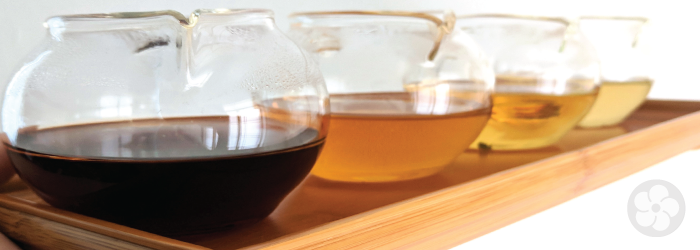Tea Myths: Do Darker Teas Have More Flavor?

It’s been proven many times that color can dramatically influence our perceptions of flavor. For example, adding dye to a white wine causes tasters to describe the flavors of red wine. This psychological quirk makes sense in the context of ripening fruit or vegetables, but doesn’t apply equally to all foods and beverages in our modern world.
In the context of tea, the association between color and flavor seems logical enough at first. You may know, for instance, that steeping tea leaves in hotter water, or leaving them to brew for a longer amount of time, will generally increase the intensity of both color and flavor in the cup. But this logic breaks down as soon as we start to consider a broader selection of teas. While the varying levels of oxidation between tea categories does produce a wide range of flavors, the differences between them can hardly be compared on a linear scale, much less one based on color.
In fact, despite the fact that some of the finest green and white teas barely have any color to the liquor at all, the impact of flavor is undeniable on the tongue. For these teas, the lack of color in the brew is actually a sign of high quality flavor.
This is because color and flavor are produced by separate chemical compounds in the leaf, with little overlap. The components that do produce both color and flavor are polyphenols, the well-known antioxidants in tea. In an unoxidized leaf, these consist mostly of theaflavins, which lend a yellowish-brown color to the brew, and contribute to the feeling of astringency, or dryness in the mouth. In black teas, oxidation converts theaflavins to thearubigins, which produce the characteristic reddish-brown color and tend to taste ashy. By contrast, the many volatile compounds that produce a tea’s sweet, fruity, or floral flavors are all colorless.
By looking at these molecular components, we can see that a naturally dark color actually correlates to undesirable flavors in most teas. Even among black teas, the highest quality leaves produce a translucent red brew, much lighter than the opaque brown color that many people expect.
To find real flavor intensity, rather than simply ashy astringency, it’s important to look for leaves that have grown slowly, either in the brisk chill of early spring or in the challenging growing conditions of high elevation tea farms. The slow growth process gives the plant time to develop complex flavor compounds and send natural sugars to the leaf.
Unfortunately, the mental connection between color and flavor have long been exploited by mass producers. Since the earliest days of the worldwide tea market, intrepid salesmen have been adding artificial colorants to increase the perceived flavor and value of their teas. Powdered colorants have been easily disguised in chopped leaves or tea dust throughout history, and today’s common food dyes make artificial color even less noticeable. Focus on the flavor on your tongue instead of the color in your cup to train your palate and avoid this common fallacy.
Sign up for our newsletter to get blog updates in your inbox!





Comments on this post (0)